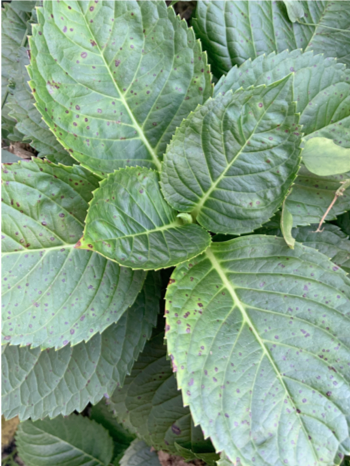Leaf Spot on Hydrangeas
go.ncsu.edu/readext?748321
en Español / em Português
El inglés es el idioma de control de esta página. En la medida en que haya algún conflicto entre la traducción al inglés y la traducción, el inglés prevalece.
Al hacer clic en el enlace de traducción se activa un servicio de traducción gratuito para convertir la página al español. Al igual que con cualquier traducción por Internet, la conversión no es sensible al contexto y puede que no traduzca el texto en su significado original. NC State Extension no garantiza la exactitud del texto traducido. Por favor, tenga en cuenta que algunas aplicaciones y/o servicios pueden no funcionar como se espera cuando se traducen.
Português
Inglês é o idioma de controle desta página. Na medida que haja algum conflito entre o texto original em Inglês e a tradução, o Inglês prevalece.
Ao clicar no link de tradução, um serviço gratuito de tradução será ativado para converter a página para o Português. Como em qualquer tradução pela internet, a conversão não é sensivel ao contexto e pode não ocorrer a tradução para o significado orginal. O serviço de Extensão da Carolina do Norte (NC State Extension) não garante a exatidão do texto traduzido. Por favor, observe que algumas funções ou serviços podem não funcionar como esperado após a tradução.
English
English is the controlling language of this page. To the extent there is any conflict between the English text and the translation, English controls.
Clicking on the translation link activates a free translation service to convert the page to Spanish. As with any Internet translation, the conversion is not context-sensitive and may not translate the text to its original meaning. NC State Extension does not guarantee the accuracy of the translated text. Please note that some applications and/or services may not function as expected when translated.
Collapse ▲Are you seeing spots on your hydrangea leaves this fall? Fungal leaf spot diseases are the most active during wet weather, and hydrangeas are particularly susceptible to several different leaf spot diseases that favor moist weather.
 Many of the leaf diseases that we see in the fall are actually the result of infections that happened in the spring and expanded as late summer rains spread them from the older bottom leaves up through the plant’s new top growth.
Many of the leaf diseases that we see in the fall are actually the result of infections that happened in the spring and expanded as late summer rains spread them from the older bottom leaves up through the plant’s new top growth.
Fungicides at this point won’t really do a whole lot. The infected leaves will still have spots until they fall off in the winter. Watering techniques will help in reducing the spread of the fungal spores. Avoid getting the leaves wet by using drip irrigation instead of overhead sprinklers, and watering early in the morning so drying can occur when the sun reaches the plant. It is also helpful to remove infected leaves to get rid of the source of the inoculum so the spores can’t spread. Remove and dispose (not compost) of the leaves that fall on the ground or that remain in the bush during the winter to limit the disease spores from the previous year.
Fungicide protection in the spring can help the new, tender leaves resist infection, especially in young plants. Fungicides containing chlorothalonil, mancozeb, or thiophanate-methyl are most effective when applied prior to the first sign of leaf spots. Reapplying every 10 to 14 days may be needed to prevent these diseases. Be sure to follow the label for application rates and safety precautions.
Another important plant management practice is the concept of “The Right Plant in the Right Place”. Before you even plant the shrub, be mindful of managing the stress it will have to endure in that location. Stress can make living things weaker and more susceptible targets for problems. Start with gathering the right “reconnaissance”. The soil is like a plant’s pantry. What’s in it? Take a soil sample up to the N.C. Department of Agriculture and Consumer Services Agronomics Lab at least every three years so you have updated information and recommendations for pH and fertility. From the beginning of April through the end of November there is no charge to NC residents. Your local N.C. Cooperative Extension office can help with providing the collection boxes, forms and sampling directions to you.
Next, select shrubs with disease resistance built in. Unfortunately, many of the popular varieties, especially when stressed with too much sunlight, are more susceptible to leaf disease. For more information about cultivars with disease resistance take a look at Cornell University’s publication Disease and Insect Resistant Ornamental Plants: Hydrangea.
Minda Daughtry is the Horticulture Agent for North Carolina Cooperative Extension in Lee County.




